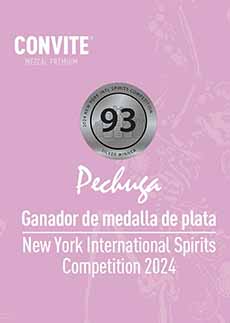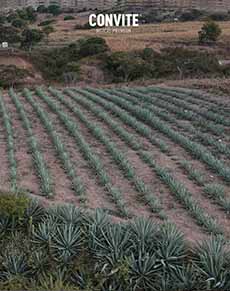Pechuga Mezcal: A Perfect Spirit For Thanksgiving (And Beyond)
|
|
When it rains it pours…delicious distilled spirits from Mexico. We recently had the pleasure of tasting our first sotol, a little-known spirit distilled not from agave, but from the Desert Spoon plant. We follow it this week with a chaser of pechuga de mezcal, a celebratory version of mezcal made for special occasions. It’s a more rare yet traditional version of mezcal that’s just right for Thanksgiving. It’s our Top Pick Of The Week. Why? Because pechuga de mezcal gets its name from its unique distillation process, which adds a raw chicken or turkey breast to the distillation. The word “pechuga” means “breast” in Spanish. And as long as we’re on the topic: > The difference between tequila and mezcal. > Other Mexican distilled spirits. The history of pechuga mezcal is not particularly old, but it is not well documented. The spirit emerged in the 19th century in the small mezcal-making distilleries (palenques) that dot the state of Oaxaca, Mexico. In those days, the mezcaleros (mezcal-making families) passed down the recipe orally, from generation to generation. This makes makes it difficult to trace back to a single individual or point of origin. Each family would have its own closely guarded recipe and technique. Recipes and techniques also varied by topography and the different botanicals and other ingredients that were available. Thus, as with many things, pechuga mezcal was probably not the work of a single inventor but rather evolved through experimentation in the community—in this case the Zapotec communities of Oaxaca, which have a long history of mezcal production. The earliest-known written reference to pechuga dates to 1863; but as in the case of most histories, the practice was likely well-established decades before references appear [source]. Who thought raw meat was a good idea to distill in mezcal? For many millions of years, there’s been a lot of conscious experimentation by “lesser” animals, from crows to octopuses to our cousins the primates, and others who exhibit the capacity for complex learning. The earliest evidence of distillation in ancient civilizations like Mesopotamia and Egypt is around 3000 B.C.E., and analysis of pottery from the Neolithic village of Jiahu in China suggests that a fermented beverage made from rice, honey, and fruit was produced around 7000 B.C.E. So whoever first thought of adding raw poultry could look back at many thousands of years of flavoring foods and beverages with botanicals—barks, flowers, fruits, herbs and spices, roots, and vegetables. It was thus that in 19th-century Oaxaca, Mexico, some person or persons added some poultry to the pot to further enhance the flavors and add complexity to the drink. They were not seeking to make the spirit taste like meat. This specialty variation of mezcal, made in limited quantitities, takes a lot of effort to produce and is been made for special celebrations, such as birthdays, quinceañeras, holidays, weddings, anniversaries, births, and baptisms [source]. Customarily, the Mexican holidays for which pechuga is made include Día de Los Muertos, Christmas, and Easter. So America, and all you other folks who celebrate Thanksgiving—in Brazil, Canada, China, Germany, Liberia, the Netherlands, the Philippines, Rwanda, Saint Lucia, the U.K., etc.—it’s time to add pechuga to our harvest holidays. Local fruits, herbs, spices, and breast of choice are added beginning with the second distillation. As the mezcal cooks in the still, the vapors mingle with these ingredients, so their flavor is instilled into the finished spirit. Convite makes the best-selling artisanal mezcal in Oaxaca. Premium products, they’re made for the most discerning palates. Convite’s Mezcal Pechuga, a special edition, was awarded the 2024 Silver Medal at the 15th New York International Spirits Competition in May. This year’s competition was notable for its high level, featuring more than 1,400 spirits from 39 countries and 38 states. Convite mezcal pechuga, distilled with creole turkey breast, unfolds layers of creamy textures and exotic notes of sweet spices and tropical fruits. The botanicals include apples, pears, tejocotes (Mexican hawthorn), and pineapples, the latter of which led to a comment that it is “reminiscent of a lively fruit punch” (in the most complementary way—the recipe is great). “Convite,” the Spanish and Portuguguese word for “invitation” (and derived from the Latin convitō) is used in Oaxaca, Mexico, to refer to a gathering of friends and neighbors to celebrate a bountiful harvest. The D.O.M.‡ brand is made sustainably with Fair Trade practices and five generations of knowledge. The distillery is located in Santiago Matatlán, Oaxaca, Mexico—specifically, in the Zapotec mountains of San Baltazar Guelavila, District of Tlacolula, in the Sierra Madre del Sur, where different types of wild agaves have long grown‡‡‡. The best and largest mezcal agaves in the world come from this area, the “mezcal region” of Mexico. It’s a magical place, with an amazing biological diversity, surrounded by mountains, stony waterfalls and springs at 1900 meters above sea level. Mezcal Convite is a high quality artisanal mezcal, made 100% in the traditional way, without any accelerators or added flavors. Using the highest quality ingredients beginning with thorough selection of wild agaves and the careful distillation adopted from ancient methods, the expressions achieve distinctive flavors and luxurious flavors. Note that most of the mezcal maguey varieties are wild. Only some, such as Agave tequilana and Agave angustifolia (commonly called maguey Espadín) are cultivated‡‡‡‡. The wild agaves used to make Convite’s seven mezcal expressions include the Coyote, Jabalí, Madrecuishe, Tepextate, Tobalá and Tobasiche. The pechuga is made from 100% wild Espadín agave. Each variety has a unique flavor**. Here’s more about them. All expressions are made in small batches in the small town of San Baltazar Guelavila, starting with carefully selected agave plants. The best agave comes at the exact point of maturity, when the plants attain the most flavor. It’s translated from Spanish into three additional languages: English, French, and Zapotec. If your local store can’t get it for you, head to the website of Hotaling, the leading distiller and importer of artisanal spirits. There’s 20% off From November 25 to December 2, 2024, for Black Friday and Cyber Monday. **There are more than 250 known agave species in the world, but only about 30 can be used to make mezcal. †Nance fruit (Byrsonima crassifolia) is a bite-sized, strongly-scented fruit that resembles a yellow-orange cherry. It grows across regions of the Caribbean and the American tropics. It’s a member of the Malpighiaceae family of flowering plants, a more famous member of which is the acerola. Other common names used in English include craboo, golden spoon, and maricao cimun. In Jamaica it is called hogberry. |
|
|
‡The Denomination of Origin for Mezcal (DOM) defines it as exclusively Mexican, and that it may be produced in specified parts of the states of Durango, Guanajuato, Guerrero, Michoacán, Oaxaca, Puebla, San Luís Potosí, Tamaulipas, and Zacatecas. ‡‡The type of wood used to roast agave can vary by region. Oak and pine are most commonly used. Different types of wood produce different smoke profiles. ‡‡‡Archaeological evidence suggests that people first harnessed the uses of wild agave 12,000 or more years ago. Agave leaves were used to make cloth and soap, and dried to make watertight roofs. The thorns were used as sewing needles and to stitch wounds [source: Google a.i. November 19, 2024]. ‡‡‡‡These agave varieties are primarily cultivated instead of harvested wild because they are the fastest growing, allowing for efficient production with high yields at a lower cost compared to many wild maguey species. Cultivated species provide a reliable and sustainable source for mezcal making. CHECK OUT WHAT’S HAPPENING ON OUR HOME PAGE, THENIBBLE.COM.
|
||













